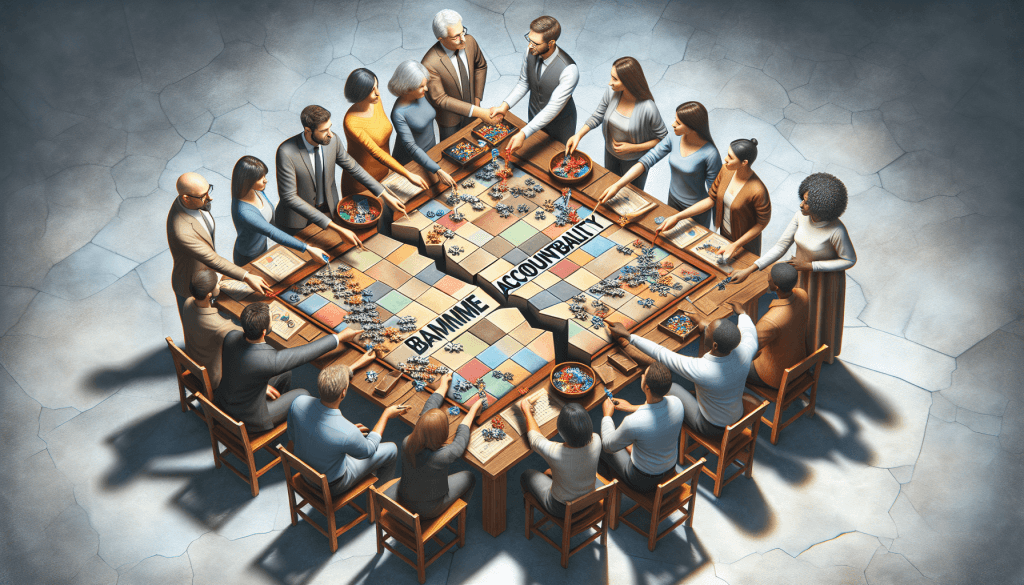Transforming blame into accountability is like turning a stormy sea into calm waters—it’s challenging, but the rewards are worth it. Blame often feels like a quick fix, a way to shift the weight of a problem off your shoulders. But in reality, it’s a trap that keeps you stuck. Accountability, on the other hand, is the key to growth, trust, and stronger relationships. So, how do you make this shift? Let’s dive in and explore.
Key Takeaways
- Blame creates division, while accountability builds trust and connection.
- Recognizing your role in conflicts is the first step to change.
- Accountability fosters emotional intimacy and strengthens relationships.
Introduction to Blame and Accountability
Defining Blame and Its Impact
Blame is like a hot potato—no one wants to hold it. It’s the act of pointing fingers, often to avoid guilt or responsibility. While it might feel satisfying in the moment, blame erodes trust and creates distance in relationships. It’s a defense mechanism, but one that often backfires.
Think about it: when was the last time blaming someone solved a problem? Probably never. Instead, it likely led to arguments, hurt feelings, or even resentment.
Understanding Accountability as a Positive Force
Accountability, on the other hand, is empowering. It’s about owning your actions and their consequences. When you take responsibility, you show integrity and maturity. It’s not about self-blame or guilt—it’s about learning and improving.
Accountability is like planting seeds in a garden. It takes effort, but the results—trust, respect, and growth—are worth it.
The Connection Between Blame and Accountability
Blame and accountability are two sides of the same coin. While blame focuses on assigning fault, accountability focuses on finding solutions. The shift from one to the other requires self-awareness and a willingness to grow.

The Problems with a Lack of Accountability
How Blame Undermines Trust in Relationships
Blame is a trust killer. When you blame someone, it sends the message that you’re unwilling to work together to solve problems. Over time, this creates a divide that’s hard to bridge.
Imagine a team where everyone blames each other for mistakes. Would that team succeed? Unlikely. The same applies to personal relationships.
The Role of Misunderstandings and Resentment
Blame often stems from misunderstandings. When you assume someone’s intentions without clarifying, it’s easy to jump to conclusions. This can lead to resentment, which is like a slow poison for relationships.
Emotional Consequences of Avoiding Responsibility
Avoiding responsibility might feel easier in the short term, but it comes at a cost. It can lead to guilt, shame, and a lack of self-respect. Plus, it prevents you from growing and improving.

Transforming Blame into Accountability
Recognizing Your Role in Conflicts
Self-Reflection and Honest Assessment
The first step to accountability is self-reflection. Ask yourself: What role did I play in this situation? Be honest, even if it’s uncomfortable.
Identifying Patterns of Blame
Do you notice a pattern of blaming others? If so, dig deeper. Is it a way to avoid guilt? Or perhaps a habit you’ve picked up over time? Recognizing these patterns is crucial for change.
Acknowledging Your Partner’s Feelings
Validating Emotions Without Defensiveness
When someone expresses hurt, resist the urge to get defensive. Instead, validate their feelings. A simple “I understand why you feel that way” can go a long way.
Building Empathy Through Open Communication
Empathy is the bridge between blame and accountability. By listening and understanding the other person’s perspective, you can foster a deeper connection.

Practical Steps to Foster Accountability
Expressing Apology or Regret
The Importance of a Genuine Apology
A genuine apology is more than just saying “I’m sorry.” It’s about acknowledging your actions and their impact.
How Apologies Promote Healing and Growth
Apologies are like a reset button. They pave the way for healing and show that you’re committed to making things right.
Offering Solutions to Rebuild Trust
Demonstrating Commitment to Change
Actions speak louder than words. Show your commitment to change through consistent actions.
Collaborative Problem-Solving in Relationships
Work together to find solutions. This not only resolves the issue but also strengthens your bond.
Acting on Your Word
The Role of Follow-Through in Credibility
Follow-through is the backbone of accountability. When you keep your promises, you build credibility.
Establishing Trustworthiness Through Consistency
Consistency is key. It shows that you’re reliable and trustworthy, which are essential for healthy relationships.

The Benefits of Accountability in Relationships
Fostering Mutual Respect and Balance
Accountability creates a sense of balance in relationships. It shows that both parties are willing to put in the effort to make things work.
Strengthening Emotional Intimacy and Connection
When you take responsibility, it deepens emotional intimacy. It shows that you value the relationship enough to own your mistakes.
Enhancing Conflict Resolution Skills
Accountability is a powerful tool for resolving conflicts. It shifts the focus from blame to solutions, making it easier to move forward.
Case Studies and Real-Life Examples
Case Study 1: The Importance of Accountability in Conflict Resolution
Consider a workplace scenario where a team member admits to a mistake and works to fix it. This act of accountability not only resolves the issue but also inspires others to take responsibility.
Lessons Learned from Successful Accountability Practices
From personal relationships to professional settings, accountability has proven to be a game-changer. It fosters trust, respect, and a sense of community.

Conclusion
Recap of the Transformative Power of Accountability
Transforming blame into accountability is a journey, but it’s one worth taking. It leads to stronger relationships, personal growth, and a more fulfilling life.
Encouragement to Embrace Accountability for Healthier Relationships
So, the next time you’re tempted to blame, pause and reflect. Choose accountability instead. It’s not just a choice—it’s a commitment to yourself and your relationships.
For more insights on personal growth and resilience, check out this guide on developing resilience. Or, explore how a resilient mindset can alter your perception of failure.
Accountability isn’t just about fixing mistakes—it’s about building a better future. So, what are you waiting for? Start today.
Transforming Blame Into Accountability: Your FAQ Guide to a Healthier Path Forward
What does it mean to transform blame into accountability?
Transforming blame into accountability involves shifting the focus from assigning fault to taking ownership of actions and their outcomes. It encourages self-reflection, growth, and constructive problem-solving instead of dwelling on negativity or finger-pointing.
Why is blaming others often counterproductive?
Blaming others can create defensiveness, erode trust, and hinder collaboration. It often focuses on the problem rather than the solution, keeping individuals or teams stuck in a cycle of negativity rather than fostering progress and understanding.
How can accountability improve relationships?
Accountability builds trust and respect by demonstrating reliability and a willingness to own up to mistakes. It fosters open communication and mutual understanding, which are essential for healthy and productive relationships.
What are some practical steps to shift from blame to accountability?
Start by acknowledging your role in a situation, practicing empathy, and focusing on solutions rather than assigning fault. Communicate openly, take responsibility for your actions, and commit to making amends or improvements where needed.
How does self-awareness play a role in this transformation?
Self-awareness helps you recognize your own biases, triggers, and contributions to a situation. By understanding these factors, you can take responsibility for your actions and respond more constructively, rather than reacting with blame.
Can transforming blame into accountability reduce workplace conflict?
Yes, fostering accountability in the workplace can reduce conflict by promoting transparency, collaboration, and mutual respect. It shifts the focus from fault-finding to problem-solving, creating a more positive and productive work environment.
What are the emotional benefits of embracing accountability over blame?
Embracing accountability can lead to personal growth, improved self-esteem, and reduced stress. It allows you to focus on solutions and progress rather than dwelling on negativity, fostering a healthier mindset and emotional resilience.
How can leaders encourage accountability within their teams?
Leaders can model accountability by owning their actions and decisions, providing constructive feedback, and creating a safe environment for open communication. Encouraging collaboration and recognizing efforts can also inspire team members to take responsibility.
What role does forgiveness play in moving from blame to accountability?
Forgiveness allows individuals to let go of resentment and focus on healing and growth. It creates space for accountability by fostering understanding and empathy, which are essential for resolving conflicts and moving forward constructively.
How can this transformation impact personal growth and development?
Transforming blame into accountability encourages self-reflection, resilience, and a proactive mindset. It helps you learn from mistakes, build stronger relationships, and develop a more constructive approach to challenges, ultimately fostering personal and professional growth.



